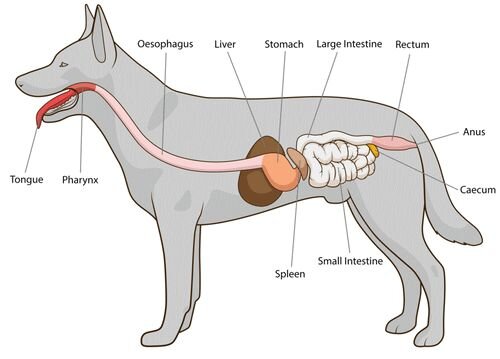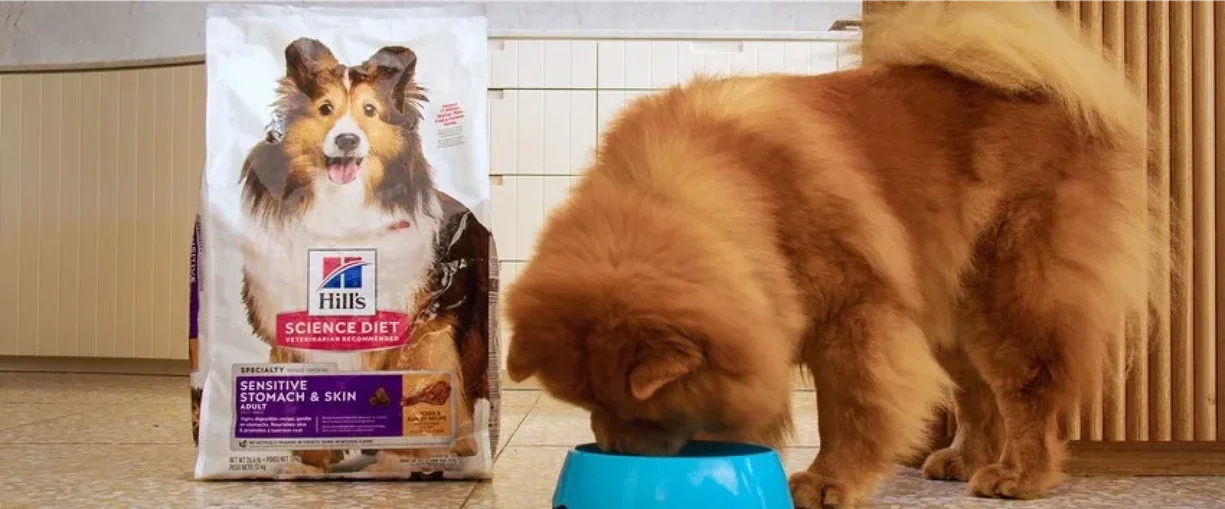Last Updated: 20/07/2025
Your Dog's Digestive System Explained
Find out how the canine digestive system works and ways that you can help maintain your dog's digestive health.
Author: Dr Teagan Lever BVSc (Hons)
Reading Time: 20 minutes - medium read
Extracting nutrients from food in order to fuel the many functions of the body is the key purpose of the dog's digestive system. It is a complex process with many components involved from mouth to tail.
In this article we will explore the canine digestive system and ways that you can help maintain your dog's digestive health, starting with answering some of the most frequently asked questions about the dog's digestive system.
How a Dog's Digestive System Works

As omnivores, the digestive system of the dog can digest a wide range of foods, including plant-based foods. Due to the fact that plant matter is more difficult to digest than meat, domestic dogs actually have a longer digestive tract compared with true carnivores such as cats.
The Digestive Process Begins with Smell
The digestion process begins before the dog even begins to eat their food. Anticipation of a meal, or the smell and sight of food stimulates the production of saliva, which aids in digestion and helps with swallowing.
Into The Mouth
The dog then uses their mouth and teeth to pick up food and begin eating. The front teeth (incisors) are suited to picking up individual pieces of food, while the larger teeth at the back are better for grinding and chewing.
The tongue also plays a part in this process, helping to move the food around the mouth and position it for chewing.
Down The Oesophagus
Once the food has been chewed into smaller pieces, the dog swallows and the food travels down the oesophagus to the stomach. It's important for pet parents to be aware that small bones such as chicken necks or wings can easily become lodged in the oesophagus and cause a blockage or injury, so it is best to avoid feeding these.
The Stomach & Intestine Begins Digesting Proteins
Inside the stomach, gastric juice is produced which contains mucus, hydrochloric acid and enzymes to begin digesting proteins.
The walls of the stomach are muscular and contract to physically mix the food as it is broken down.
When the gastric contents are thoroughly mixed they form a thick milky liquid known as chyme. The chyme then passes through the pyloric sphincter of the stomach into the first part of the small intestine, the duodenum.
In the duodenum, more enzymes are secreted from the intestinal wall and the pancreas, including proteases for protein digestion, amylase for carbohydrate digestion and lipase for fat digestion.
Pancreas, Liver & Intestines
The pancreas also secretes sodium bicarbonate, which neutralises the acidic chyme to allow the digestive enzymes to function.
Bile, which is produced in the liver and stored in the gallbladder, is also released into the small intestine to help break down fats into smaller globules ready to be digested by lipase from the pancreas.
Once proteins and carbohydrates have been broken down by the digestive enzymes, their components are able to be absorbed across the wall of the intestine into the bloodstream. Fat is absorbed into the lymphatic system before it eventually ends up in the blood.
Once the food makes it to the large intestine, the bulk of its nutrients have been digested and absorbed. In the large intestine, water is absorbed and there is some fermentation of fibre by bacteria, known as the gut microbiome.
An imbalance of desirable and undesirable bacteria within the gut microbiome can result in excessive fermentation causing symptoms like flatulence or diarrhoea.
Out The Rectum
Once the undigested remnants of the food reach the end of the large intestine, they constitute faeces, which are stored in the rectum and passed through the anal sphincter when your dog takes a toilet break.
There are a variety of factors that can cause upsets to the digestive systems of dogs, including stress, diet and bacterial imbalance in the intestines. By feeding a high quality diet, particularly one designed to support optimal digestion, like Hill's Science Diet, you can help to keep your dog feeling happy and healthy inside and out.
Maintaining Your Dog's Digestive System Health

Problems with the digestive system can cause a variety of symptoms including vomiting, diarrhoea and flatulence. There are a number of things which can cause upsets to your dog's digestive system including:
- Stress
- Parasites
- Dietary indiscretion (eating something they shouldn't)
- Feeding food or treats that are very high in fat
- Feeding bones
- Ingestion of foreign objects (e.g. socks)
- Food sensitivities
- Inflammation of the pancreas
- Bacterial imbalance in the intestines
How to improve your dog's digestive health
Avoid feeding your dog human foods, particularly those that are fatty, look instead for easy to digest treats with a low to moderate fat content.
It is recommended to keep treats to about 10% of your dog's total caloric intake. Bones and foreign objects can cause blockage, injury or inflammation of the digestive system and are best avoided.
One of the best things you can do to support your dog's digestive system health is to feed a high quality, balanced and easy-to-digest food, like Hill's Science Diet. It can also be beneficial to feed a food or designed to support a healthy gut microbiome.
Hill's Science Diet Canine Perfect Digestion contains Hill's exclusive blend of prebiotics, ActiveBiome+, to support each pet's unique microbiome for healthy digestion and overall well-being.
The Hill's Science Diet range has a food to suit every stage of your dog's life.
They have diets for puppies, adults and senior pets with options for small and large breeds.
They also have diets that provide nutrition for a variety of needs, including:
Top Questions about your Dog's Digestive System
A deep understanding of your dog's digestive system is fundamental to their overall health. While many factors can cause digestive upset, the most significant contribution you can make to their well-being is through a consistent, high-quality diet.
By providing your dog with an easily digestible food, you actively prevent common issues and support their health from the inside out, ensuring they remain a happy and active companion.
Further Reading
Want to read more? Check out our other articles:
Raw pet food: The benefits and risks
History
Our experts continually monitor the health and wellness space and we update our articles when new information becomes available.
Wed 17 May 2023
Written by Dr Teagan Lever BVSc (Hons)Dr Teagan Lever BVSc (Hons)
Head Veterinarian, BVSc (Hons)
Pet Circle's Head Veterinarian, Dr Teagan graduated from the University of Queensland in 2010 and went on to work in small animal and mixed practice in various locations around QLD & ACT before joining Pet Circle in early 2016. Dr Teagan has special interests in dermatology, nutrition and preventative health care. She feels privileged to witness the special bond people share with their pets on a daily basis and enjoys forming lasting relationships with pet parents and their fur children.

